Complete Solutions to JEE Main of chapter ELECTROSTATICS of Class 11 book with complete answers and questions
| Class 11 | PHYSICS |
| Chapter | ELECTROSTATICS |
| DC PANDEY MASTER PROBLEM PACKAGE | JEE Main |
| Number Of Questions | 71 |
| Academic Year | 2023-24 |
Figure represents a square carrying changes `+q,+q,-q,-q` at its four corners as shown. Then the potential will be zero at points
 03:20View Solution
03:20View SolutionA particle of charges Q and mass `m` travels through a potential difference V from rest. The final momentum of the particle is
03:12View SolutionThree concentric conducting spherical shells carry charges as : `+4Q` on the inner shell, `-2Q` on the middle shell and `-5Q` on the outer shell. The charge on the inner surface of the outer shell is
03:15View SolutionFigure shows thick metallic sphere. If it is given a charge `+Q`, then electric field will be present in the region
 02:59View Solution
02:59View SolutionThe work done against electric in increasing the potential difference of a condenser from 20 V to 40 V is W. The work done in increasing its potential difference from 40 V to 50 V will be
03:23View SolutionThe plate separation in a parallel plate condenser and plate area is A. If it is charged to V volt battery is diconnected then the work done increasing the plate separation to 2d will be
05:38View SolutionThe effective capacity with the following figure between the points P and Q will closest to
 05:29View Solution
05:29View SolutionA parallel plate condenser is connected to a battery of e.m.f. 4 volt. If a plate of dielectric constant inserted into it, then the potential difference on condenser will be
03:35View SolutionIn the above problem, if the battery is disconnected before inserting the dielectric, then difference will be
04:19View SolutionTwo parallel plate condensers of capacity `20 mF` and `30 mF` are charged to the potentials of 30 V and respectively. If likely charged plates are conneted together then the common potential difference be
04:27View SolutionThe minimum number of condensers each capacitance of `2 muF`, in order to obtain result capacitance of `5 muF` will be
03:12View SolutionThe equivalent capacitance between points P and Q of the combination shown in figure is
 02:01View Solution
02:01View SolutionThe total energy stored in the condenser system shown in the figure will be
 04:20View Solution
04:20View SolutionFour charges are arranged at the corners of a square ABCD, as shown. The force on a positive charge kept at the centre of the square is
 04:14View Solution
04:14View SolutionFigure shows the electric field lines around an electric dipole. Which of the arrows best represents the electric field at point P ?
 02:01View Solution
02:01View SolutionPoint `P` lies on the axis of a dipole . If the dipole is rotated by ` 90^@` anti-clock wise , the electric field vector ` vec E` at `P` will rotate by .
01:31View Solution4 charges are placed each at a distance `a` from origin . The dipole moment of configuration is .
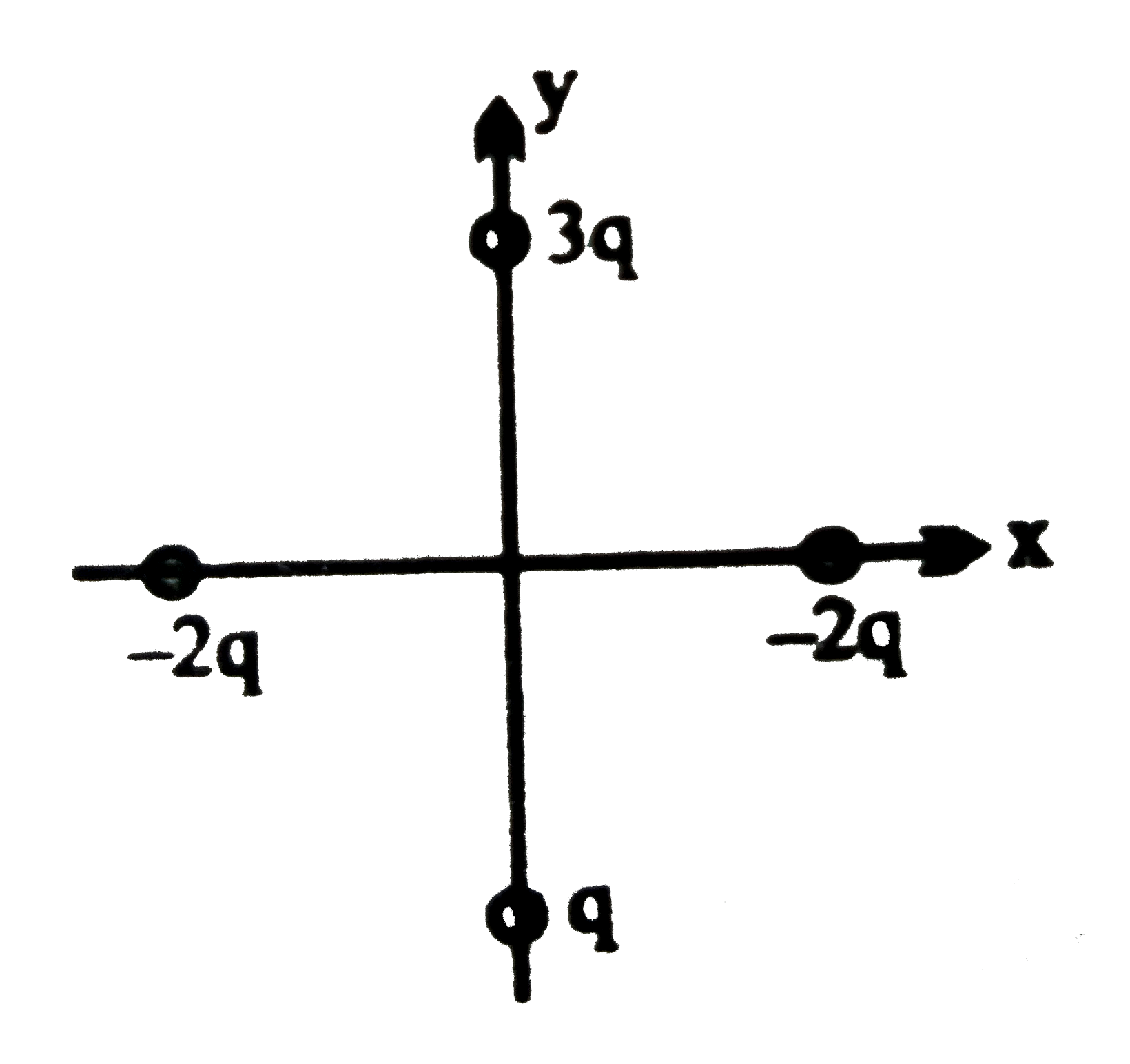 .03:59View Solution
.03:59View SolutionIf the electric potential of the inner metal sphere is `10` volt & that of the outer shell is `5` volt then the potential at the centre will be
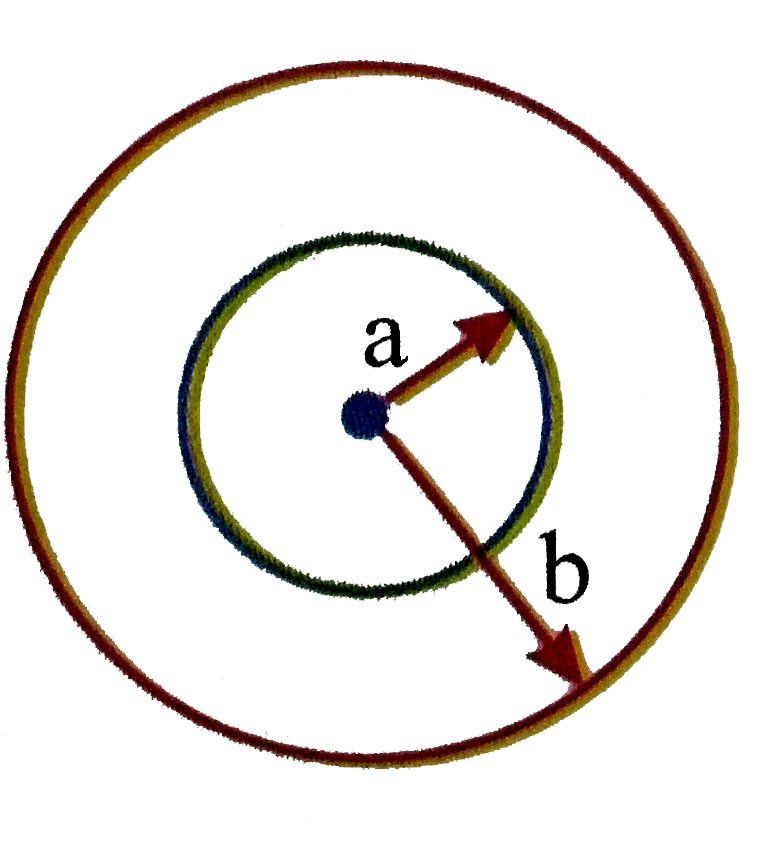 02:38View Solution
02:38View SolutionA solid sphere of radius R has charge q uniformly distributed over its volume. The distance from it surfce at which the electrostatic potential is equal to half of the potential at the centre is
02:04View SolutionA particle of charge ` 1 mu C & ` mass `1 mg` moving with a velocity of ` 4 m//s` is subjected to a uniform electric field of magnitude ` 300 V m` for ` 10 sec`. Then it's final speed cannot be :
04:24View SolutionWhat is the equivalent capacitance of the system of capacitors between `A & B`
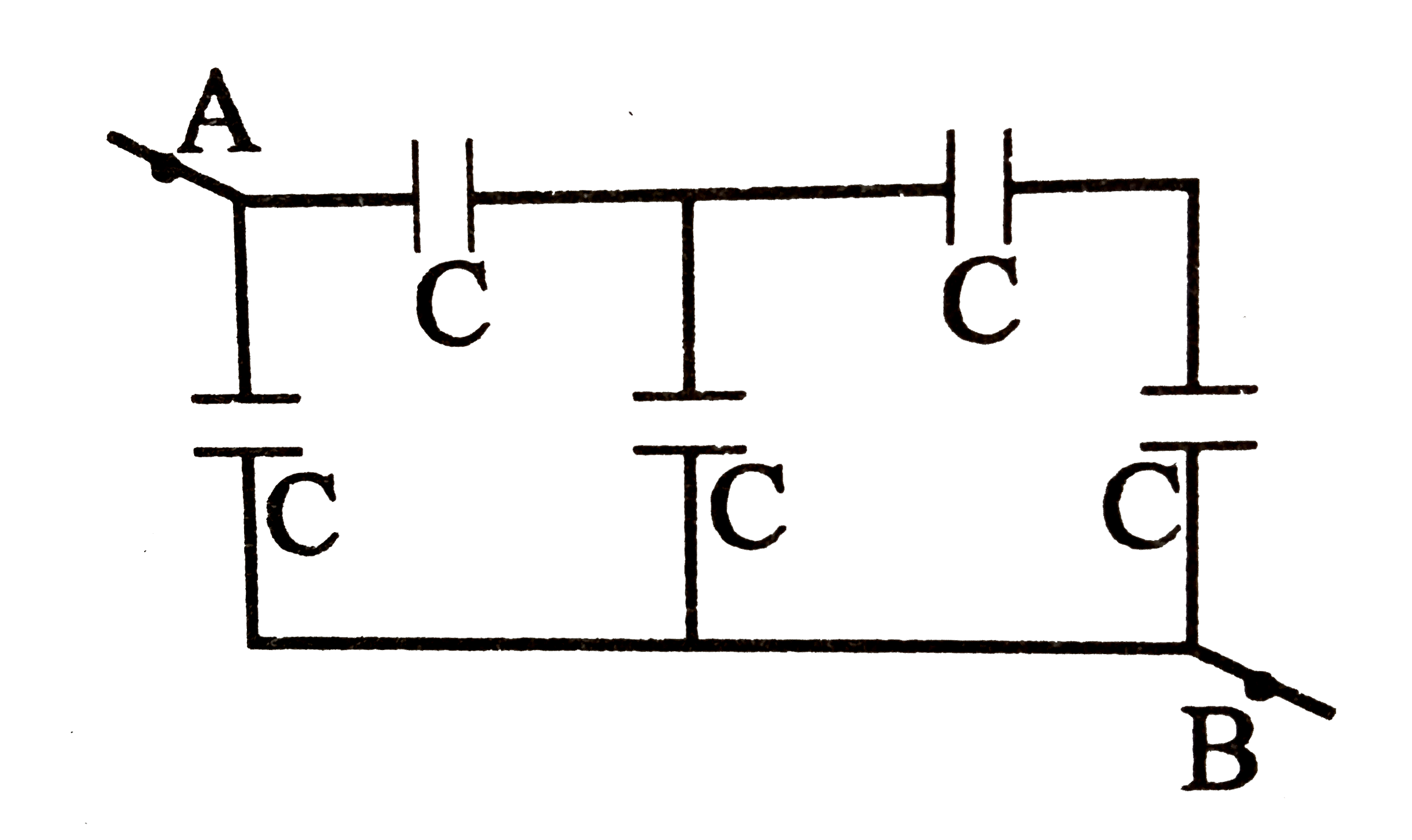 02:17View Solution
02:17View SolutionThree capacitors `2muF`, `3muF` and `5muF` can withstand voltages to `3V`,`2V` and `1V` respectively. Their series combination can withstand a maximum voltage equal to
03:33View SolutionTwo charged particles are placed at a distance 1.0 cm apart. What is the minimum possible magnitude of the electric force acting o each charge?
01:29View SolutionElectric field on the axis of a small electric dipole at a distance r is `vec(E)_(1)` and `vec(E)_(2)` at a distance of `2r` on a line of perpendicular bisector is
02:33View SolutionThe point charges `-2q, -2q` and `+q` are put on the vertices of an equilateral triangle of side `a`. Find the work done by some external force in increasing the separation to `2a` (in joules).
07:50View SolutionA point charge q is placed inside a conducting spherical shell of inner radius 2R and outer radius 3R at a distance of R fro the centre of the shell. The electric potential at the centre of shell will (potential at infinity is zero).
02:35View SolutionFigures shows three spherical and equipotential surfaces `1,2` and `3` round a point charge `q`.The potential difference `v_(1)-v_(2)=V_(2)-V_(3)` if `t_(1)` and `t_(2)` be the distance between them ,then
 02:23View Solution
02:23View SolutionThe distance between plates of a parallel plate capacitor is `5d`. Let the positively charged plate is at `x=0` and negatively charged plate is at `x=5d`. Two slabs one fo conductor and other of a dielectric of equal thickness `d` are inserted between the plates as shown in figure. Potential verus distance graph will look like:
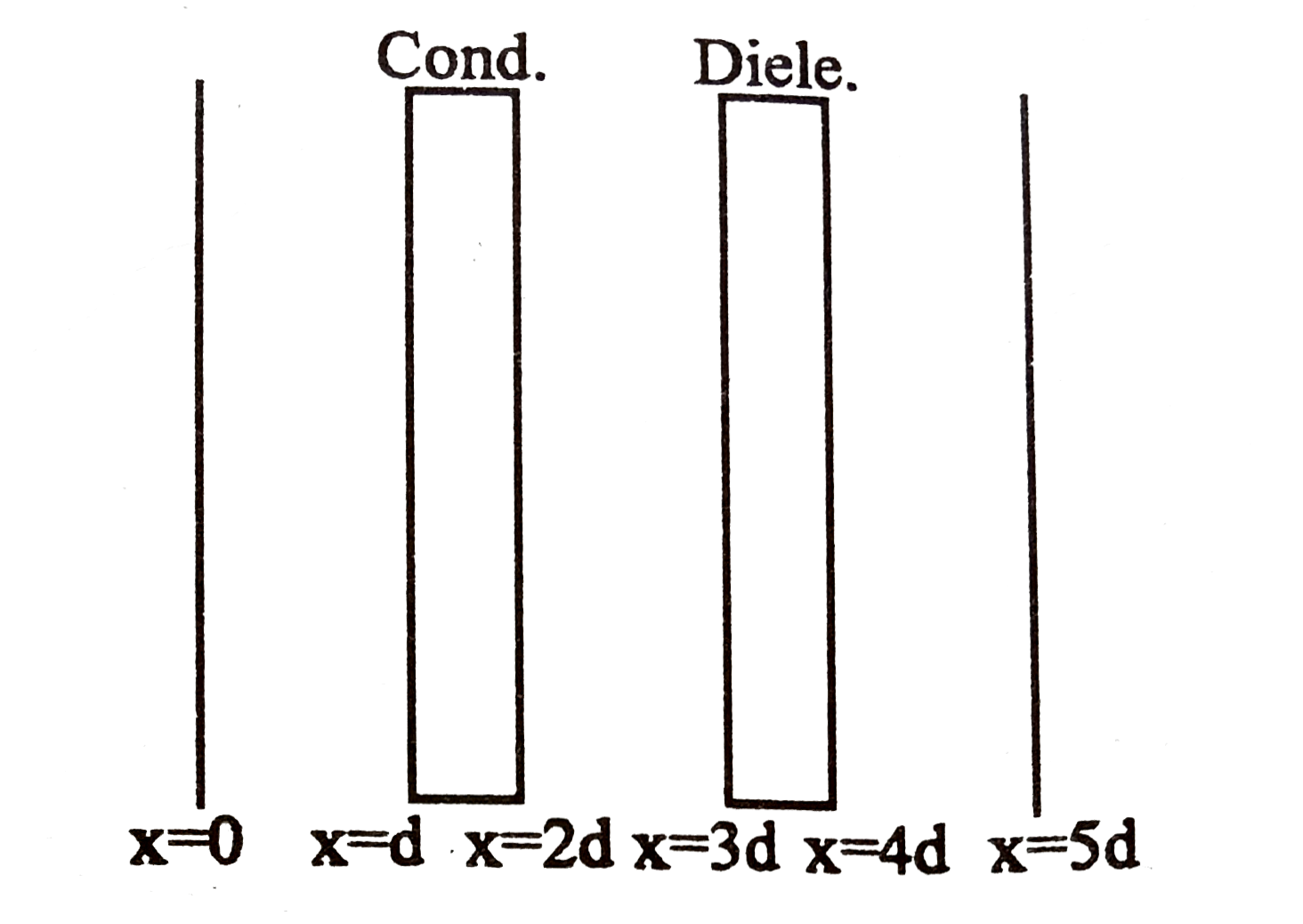 06:36View Solution
06:36View SolutionA point charge q is placed at a distance of r from cebtre of an uncharged conducting sphere of rad `R(lt r)`. The potential at any point on the sphere is
08:01View SolutionAn electric field is given by `vec(E)=(yhat(i)+xhat(j))N/C`. Find the work done (in J) in moving a `1 C` charge from `vec(r)_(A)=(2hat(i)+2hat(j))` m to `vec(r)_(B)=(4hat(i)+hat(j))m`.
02:21View SolutionCapcity of a spherical capacitor is `C_(1)` when in sphere is charged and outer sphere is earthed and when inner sphere is earthed and outer sphere charged. Then `(C_(1))/(C_(2))` is (a = radius of inner sphere b = radius of outer sphere)
05:12View SolutionThe capacitance of a capacitor between` 4//3` times its original value if a dielectric slab of thickness `t=d//2` is inserted between the plates (d is the separation between the plates). What is the dielectric consant of the slab?
01:59View SolutionThe plates of a parallel plate capacitor are charged up to `100 v`. Now, after removing the battery, a `2 mm` thick plate is inserted between the plates Then, to maintain the same potential deffernce, the distance betweem the capacitor plates is increase by `1.6 mm`. The dielectric canstant of the plate is .
02:50View SolutionA capacitor is connected to a battery. The force of attraction between the plates when the separation between them is halved.
04:15View SolutionA number of spherical conductors of different radius have same potential. Then the surface charge density on them.
03:41View SolutionThree charged particles are initially in position `1`, "They are free to move and they come in position" `2` "after some time. Let" `U_(1)` and `U_(2)` be the electrostatic potential energies in position `1 and 2`. Then
02:15View SolutionAn insulator plate is passed between the plates of a capacitor. Then current
 .02:23View Solution
.02:23View SolutionTwo point charges 2q and 8q are placed at a distance r apart. Where should a third charge `-q` be placed between them so that the electrical potential energy of the system is a minimum
12:24View SolutionA capacitor of capacitance `10 mu F` is charged to a potential `50 V` with a battery. The battery is now disconnected and an additional charge `200 mu C` is given to the positive plate of the capacitor. The potential difference across the capacitor will be.
04:00View SolutionA parallel plate capacitor has two layers of dielectrons as shown in figure. This capacitor is connected across a battery, then the ratio of potential difference across the dielectric layers is
 02:44View Solution
02:44View SolutionIn the circuit shown in figure 3.141, find the energy stored in `4muF` capacitor in steady state.
 07:00View Solution
07:00View SolutionIn the given arrangement of the capacitors, one `3mu F` capacitor has got `600 mu J` of energy. Then the potential difference across `2 mu F` capacitor is
 03:28View Solution
03:28View SolutionAn alpha particle of energy `5 MeV` is scattered through `180^(@)` by a found uramiam nucleus . The distance of closest approach is of the order of
03:35View SolutionA hollow metal sphere of radius 5 cm is charged such that the potential on its surface is `10V`. The potential at the distance `3 cm` from the centre of the sphere is:
01:22View SolutionTwo equal negative charges `-q` are fixed at points `(0, -a)` and `(0,a)` on y-axis. A poistive charge Q is released from rest at point `(2a, 0)` on the x-axis. The charge Q will
06:29View SolutionA charge q is placed at the centre of the line joining two equal charges Q. The system of the three charges will be in equilibrium if q is equal to:
03:43View SolutionA charge `q` is placed at the centre of the cubical vessel (with one face a open) as shown in figure. The flux of the electric field through the complete vessel is
 03:05View Solution
03:05View SolutionA parallel plate capacitor is charged and then isolated. On increasing the plate separation
03:47View SolutionOn placing dielectric slab between the plates of an isolated charged condenser its
05:07View SolutionThe time constant of charging of the capacitor charging of the capacitor shown in figure is
 03:08View Solution
03:08View SolutionTime constant of a C-R circuit is `2/(ln(2))` second. Capacitor is discharged at time `t=0`. The ratio of charge on the capacitor at time `t=2s` and `t=6s` is
02:13View SolutionIn the circuit shown in figure `C_(1) = 2 C_(2)`. Capacitance `C_(1)` is charged to a potential of V. The current in the circuit just after the switch S is closed is
 03:02View Solution
03:02View SolutionA `4 muF` capacitor, a resistance of `2.5 M Omega` is in series with `12V` battery. Find the time after which the potential difference across the capacitor is 3 times the potential difference across the resistor. [ Given In (2) = 0.693]
06:41View SolutionA certain charge Q is divided into two parts q and `Q-q`, wheich are then separated by a cetain distance. What must q be in terms of Q to maximum the electrostatic repulsion between the two charges?
03:08View SolutionTwo particles (free to move) with charges `+q` and `+4q` are a distance L apart. A third charge is placed so that the entire system is in equilibrium.
(a) Find the location, magnitude and sign of the third charge.
(b) Show that the equilibrium is unstable.10:23View SolutionFour equal positive charge are fixed at the vertical of a square of side L. Z-axis is perpendicular to plane of the square. The point `Z=0` is the other. The plot of electic field due to the charges, as one moves on the Z-axis is
12:01View SolutionFour equal charges of magnitudes `q` each are placed at four corners of a square with its centre at origin and lying in y-z plane. Aa fifth charge `+Q` is moved along x-axis. The electrostatic potential energy (U) varies on x-axis as
05:56View SolutionTwo small conductors A and B are given charges `q_(1) and q_(2)` respectively. Now they are placed inside a hollow metallic conductor C carrying a charge Q. If all the three conductors A, B and C are connected by a conducting wire as shown, the charges on A,B and C will be respectively :
 03:42View Solution
03:42View SolutionFind power produced in `5 Omega` resistance in steady state after closing the switch S :
 02:34View Solution
02:34View SolutionTwo particles are held in equilibrium by the gravitational and electrostatic forces between them. Particle-A has mass `m_(alpha)` and charge `q_(alpha) ` and particle-B has mass `m_(b)` and charge `q_(b)`. The distance between the charges may cause the chages to accelerate towards one another ?
05:01View SolutionA particle of mass m and charge `-q` is projected from the origin with a horizontal speed v into an electric field of intensity E directed downward. Choose the wrong statement. Neglect gravity
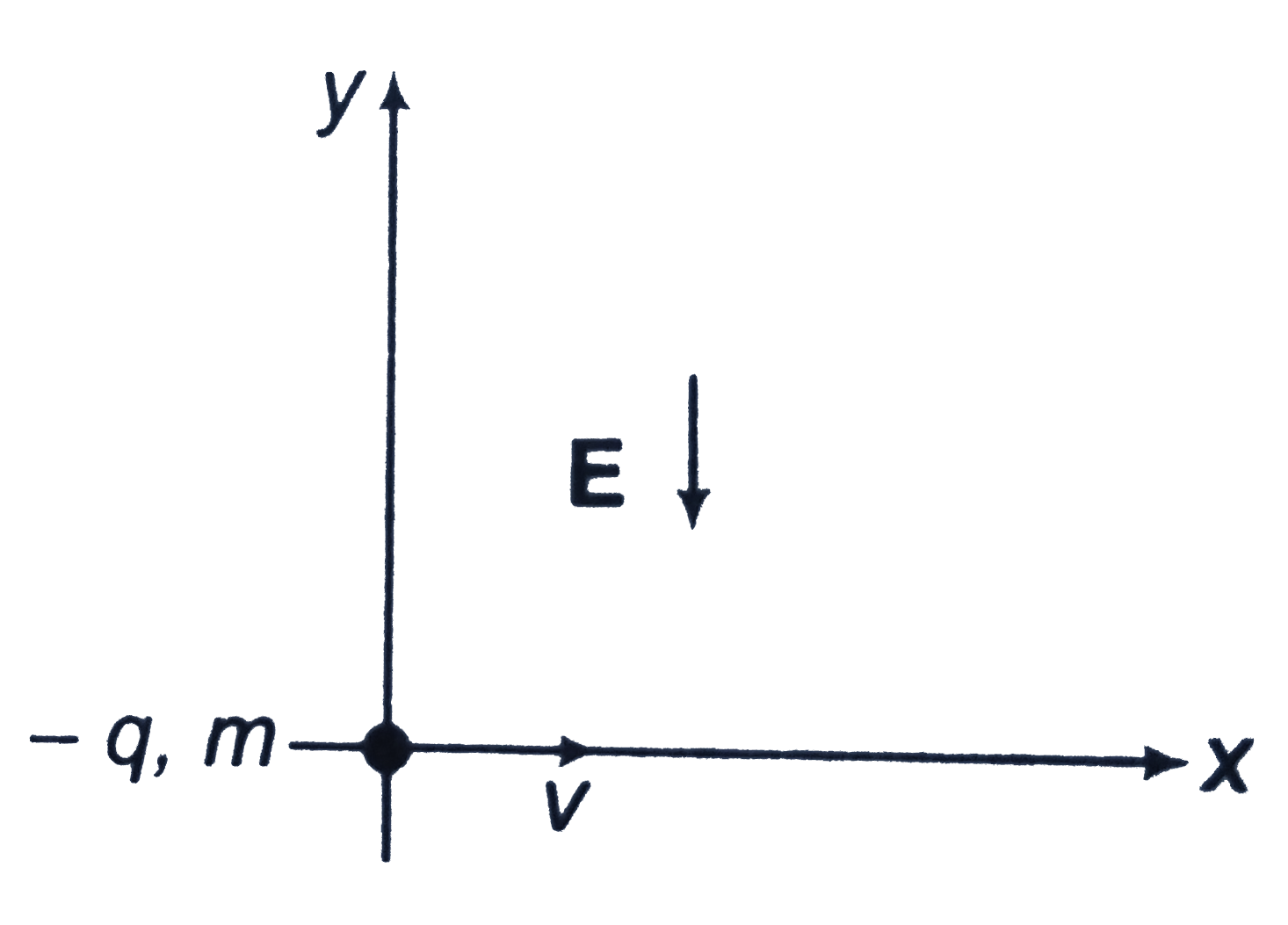 05:25View Solution
05:25View SolutionA proton a deutron and an `alpha` particle are accelerated through potentials of `V, 2V` and `4V` respectively. Their velocity will bear a ratio
02:33View SolutionFour charges of `6 muC,2muC,-12muC and 4 muC` are placed at the corners of a square of side 1m. The square is in x-y plane and its centre is at origin. Electric potential due to these charges is zero everywhere or the line
04:02View SolutionFour point charges `+q,+q,-q and -q` are placed on the corners of a square of side length 'a' as shown in the figure. The magnitude of electric field at a point which is at a distance `x (gt gt a)` from the centre along a line perpendicular to the plane of the square and passing through the centre is
 06:27View Solution
06:27View SolutionTwo identical small conducting spheres having unequal positive charges `q_1` and `q_2` are separated by a distance r. If they are now made to touch each other and then separated again to the same edistance, the electrostatic formce between them in this case will be
03:37View SolutionA capacitor of capacitance `2muF` is charged to a potential difference of `5V`. Now, the charging battery is disconected and the capacitor is connected in parallel to a resistor of `5Omega` and another unknown resistor of resistance `R` as shown in figure. If the total heat produced in `5Omega` resistance is `10muJ` then the unknown resistance `R` is equal to
 02:49View Solution
02:49View SolutionIn the figure, two point charges `+q and -q` are placed on the x-axis at `(+a,0) and (-a,0)` respectively. A tiny dipole of dipolem moment (p) is kept at the origin along the y-axis. The torque on the dipole equals
 03:42View Solution
03:42View SolutionFour point charges are kept on y-axis at `(0,a),(0,2a),(0,-a) and (0,-2a)` as shown in the figure. Which of the following graphs, best represents the variation of electrostatic potential V as a function of distance `x` from the origin, on the x-axis.
 04:25View Solution
04:25View SolutionAn electron goes from one equi-potential surface another along one of the four paths shown in diagram. Rank the paths according to the work by the electrostatic force from the least to greatest.
 02:38View Solution
02:38View SolutionThree large conducting plates carrying charges `Q,2Q and 3Q` on them, are placed parallel to each other as shown in the figure. If `U_(1) and U_(2)` denote electrostatic potential energy in the space between `1^(st)` and `2^(nd)` plane and `2^(nd)` and `3^(rd)` plate respectively as indicated, then `(U_(2))/(U_(1))` equals
`\`06:44View SolutionA metal sphere of radius 'a' is having charge `+Q`. Now it is connected by a conducting wire concentric spherical shell of radius '2a'. Then the potential at the surface of outer shell is

Here, `K=(1)/(4pi epsilon_(0))`04:49View Solution
JEE Main questions and complete solutions for chapter ELECTROSTATICS of DC PANDEY PHYSICS (HINGLISH) of Class 11
